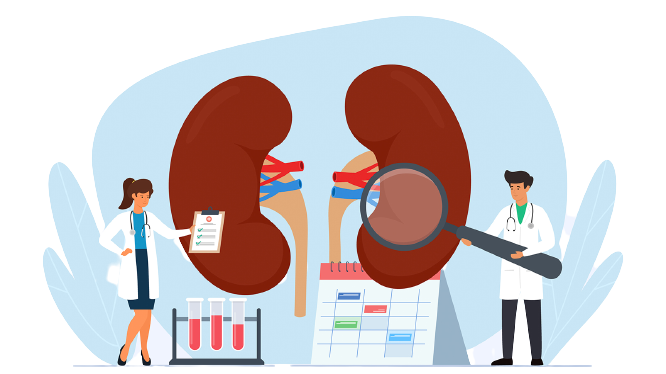
Laparoscopic Kidney Surgery
What is laparoscopic surgery? Laparoscopic surgery is a surgical technique with the most modern special surgical instruments in which the surgeon places a camera inside

Laparoscopic surgery is a surgical technique with the most modern special surgical instruments in which the surgeon places a camera inside the patient’s abdomen and operates on different organs inside. Laparoscopic operations are performed through very small incisions of 5 mm to 10 mm, resulting in minimal scarring and great comfort for the patient. This technique involves placing a small high definition camera through a small incision, which is barely visible after six months, to perform the entire operation. The advantage of using this high definition camera is that it gives an extremely crystal clear view inside the body so operations are performed with utmost precision and can even reach areas that are difficult to reach during open surgery.
Laparoscopic surgery developed in the 1990s, with the gallbladder and appendix being the earliest surgeries performed using this technique. There was a time when most gallbladder surgery was done through traditional open surgery through a long incision in the front of the abdomen, but now most patients want to have their gallbladder removed laparoscopically. One of the biggest advantages of laparoscopic surgery is that very small incisions are required for highly complex high-end surgeries. This is especially important in urological operations. A traditional open surgical incision in the kidney involves cutting the strong back muscles as well as the front abdomen. A traditional incision is usually between 20-30cm in length as the incision extends from the back to the front. This requires the muscle to be cut so is more painful for the patient. Access to the kidney also requires cutting the 12th rib so the entire procedure is more painful. All these problems are avoided in laparoscopic urological surgery because the incision is usually 2-3 cm in most kidney and urethral operations.
Laparoscopic surgery developed in the 1990s, with the gallbladder and appendix being the earliest surgeries performed using this technique. There was a time when most gallbladder surgery was done through traditional open surgery through a long incision in the front of the abdomen, but now most patients want to have their gallbladder removed laparoscopically. One of the biggest advantages of laparoscopic surgery is that very small incisions are required for highly complex high-end surgeries. This is especially important in urological operations. A traditional open surgical incision in the kidney involves cutting the strong back muscles as well as the front abdomen. A traditional incision is usually between 20-30cm in length as the incision extends from the back to the front. This requires the muscle to be cut so is more painful for the patient. Access to the kidney also requires cutting the 12th rib so the entire procedure is more painful. All these problems are avoided in laparoscopic urological surgery because the incision is usually 2-3 cm in most kidney and urethral operations.
After laparoscopic surgery the patients can go home early, require less amount of painkillers an the incision heals very nicely. Since the incision is small it never leads to development of hernia in future. Another advantage to the patient is that the patient starts eating up early after the operation and there is less bleeding so usually blood transfusion is not required. After the surgery the patient usually goes back home in two days and can resume his daily routine work or can join office after a week. In open surgery since the incision is long and takes more time to heal, so usually they are discharges after 4-5 days and can not resume work by even two weeks. In fact the actual healing of the incision takes around 6 weeks to six months. The main advantage to the surgeon is that with the help of the high definition camera the vision is very clear and the field of vision is also extensive. Since in the open surgical operations the vision gets limited in the peripheral areas, this form of surgery is better in that aspect. In today’s date almost all leading specialist centers have started such kinds of operations for the kidney.
Recovery is usually uneventful in most cases, and most patients resume eating after one day and are discharged from the hospital two days after surgery. In laparoscopic surgery, the entire operation is performed through 5-10 mm incisions with the insertion of special instruments.
Best Kidney Transplant Surgeon India, Best Kidney Transplant Hospital in Punjab, Best Urologist, Super Specialist Kidney Surgeon Chandigarh, Mohali, Panchkula, Leading Uro Oncologist Ludhiana, HP, Baddi, Punjab, Himachal, Haryana, Best Kidney Transplant Surgeon India, K. Punjab, Best Urologist, Super Specialist Kidney Surgeon Chandigarh, Mohali, Panchkula, Leading Uro Oncologist Ludhiana, HP, Baddi, Punjab, Himachal, Haryana
Other than gallbladder removal, what operations can be performed laparoscopically?
Most abdominal operations these days are performed laparoscopically, and gallbladder removal is the most common. Almost all abdominal operations which were earlier done through open surgery like removal of uterus, ovaries, intestinal operations, removal of stomach, liver, spleen etc. are now done laparoscopically in specialist centers. Kidney surgery is a type of superspecialty surgery and requires high-quality laparoscopic equipment and laparoscopic expertise. The technique of laparoscopic kidney surgery has evolved in the 21st century and is now well established and standardized and has now reached a level of perfection. Now almost all kidney operations can be done using high end laparoscopy.

What is laparoscopic surgery? Laparoscopic surgery is a surgical technique with the most modern special surgical instruments in which the surgeon places a camera inside
Welcome to WordPress. This is your first post. Edit or delete it, then start writing!
Welcome to Dr. Mukundan Subramanian’s website. He is an experienced ENT, Head & Neck Surgeon with more than 16 years of experience.